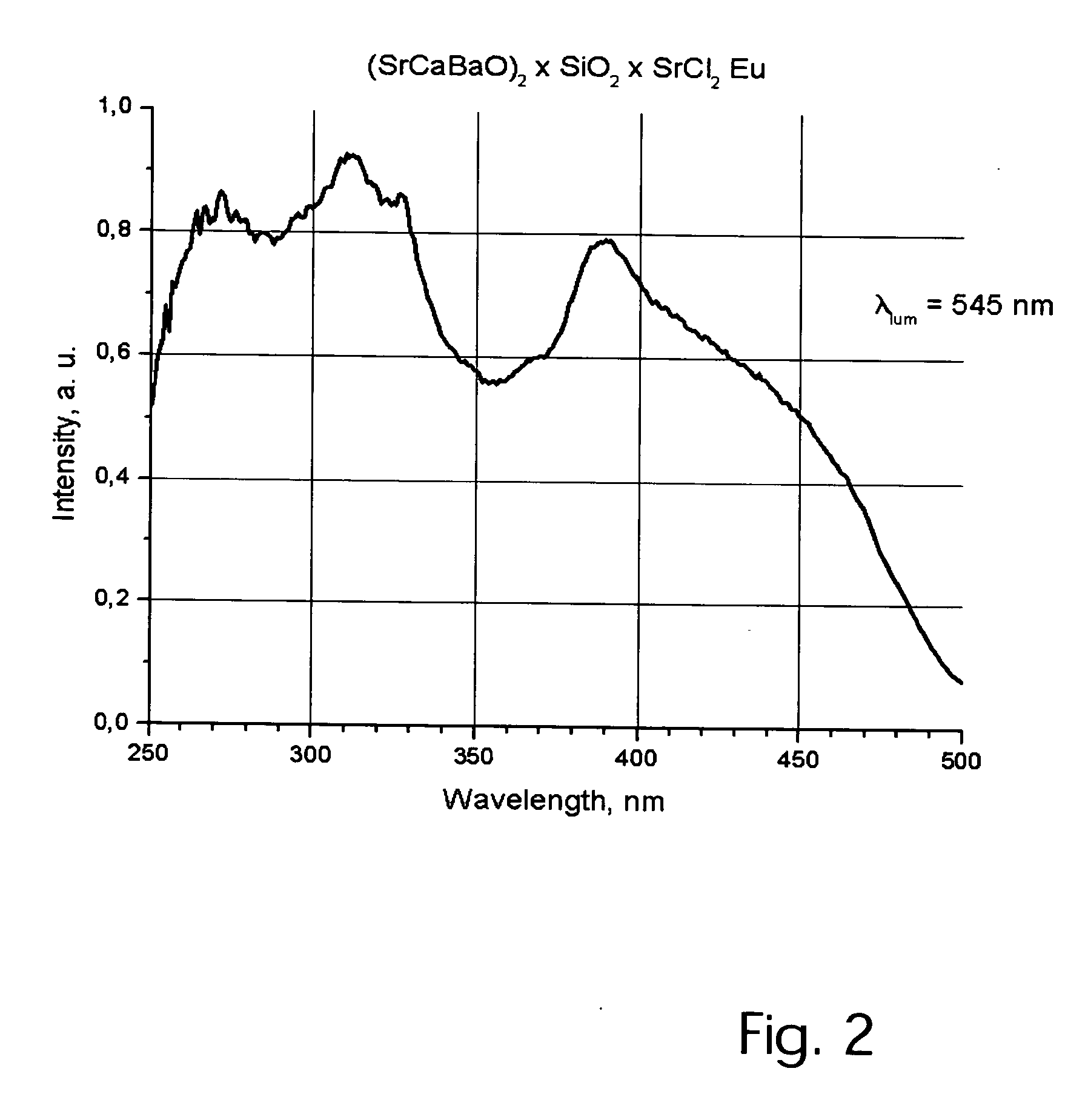Light emitting halogen-silicate photophosphor compositions and systems
- Summary
- Abstract
- Description
- Claims
- Application Information
AI Technical Summary
Benefits of technology
Problems solved by technology
Method used
Image
Examples
example 1
[0072] Mix 0.1M Sr(OH)28H2O; 0.05M SrF2; 0.05M SrCl2 with 0.005M europium nitrate (as 1% solution). Add 0.1M silica in the form of its highly dispersated technical trademark “Aerosil 100” into the mixture moistened by water. The mixture is dried at T=120° C. until dusting and is located at an alundum capsule with volume V=250 ml. The capsule is covered with a quartz cover and put to hydrogen conveyor oven in which the atmosphere is maintained with 5% H2 concentration (95% N2). The calcination of mixture is realized by means of gradual temperature elevating: T=240° for 1 hour, T=800° for 1 hour, T=1250° for 2 hours. The phosphor sample is cooled with oven cooling, at a rate of about 10° / minute. After cooled to 50° C., the resulting product is washed in a hot water bath with 1% NH4HF2 dissolved in it. The washed product Sr2SiO3(F,Cl)2 is dried at T=120° C. for 2 hours, sifted through the sieve with 50.0 micron apertures. Measuring of lighting parameters of the concrete sample 1-1 show...
example 2
[0073] 0.08M Sr(OH)2; 8H2O 0.02M Ba(OH)2; 8H2O; 0.002M Eu(NO3)3 (in the form of 0.1% solution) 0.05M SrF2; 0.05M SrCl2 are mixed in a parceline bowl V=400 ml. Into a wet mixture 0.1M fine-despersed silica “Aerosil-100” is added and dried until dusting at T=120° C. The mixture is put into alundum capsule V=500 ml, which is located to a hydrogen oven with bulk concentration of hydrogen [H2]=6%. The sample heating is made gradually, first at T=300° for 1 hour; then at T=900° C. for one additional hour and T=1280° C. for 2 hours. The capsule cooling is made together with the oven cooling with rate of 10° / minute. Thereafter, the sample is washed with a distillated water at T=50° C., dried and sifted through a sieve with 50.0 micron. Photophosphors of Table 2 having number 2-6 has the spectrum maximum position λ=527 with halfwidth λ0.5=85 nm. Photophosphor grains with a median diameter of d50=7.5 micron. Silicon organic phosphor suspension with its mass concentration 45% allows to make li...
example 3
[0074] 0.2M Sr(OH)2; 8H2O 0.005M Eu(NO3)3 (solution 0.1%); 0.05M SrF2; 0.05M SrCl2 are mixed in alundum capsule with volume 250 ml. 0.1M SiO2 is added to a wet mixture, then mixed thoroughly and dried. The capsule is placed in a hydrogen oven of atmosphere: H2—2%; N2—98, which is gradually heated up to T=320° C. for 1 hour; T=820° C. for 1 hour; then T=1300° C. for 2 hours. The capsule is taken off at T=50° C., washed by a hot water, sifted through the sieve having 50.0 micron holes. The resulting photophosphor grains have a median diameter d50=4 micron, the average diameter, dav is about 6 micron. Phosphor color coordinates are x=0.40, y=0.44. In combination with silicon gel in proportion 30-70 (by mass) the phosphor provides white-rosy luminescence color together with a light-emitting device having a pump wavelength λ=460 nm.
PUM
 Login to View More
Login to View More Abstract
Description
Claims
Application Information
 Login to View More
Login to View More - R&D
- Intellectual Property
- Life Sciences
- Materials
- Tech Scout
- Unparalleled Data Quality
- Higher Quality Content
- 60% Fewer Hallucinations
Browse by: Latest US Patents, China's latest patents, Technical Efficacy Thesaurus, Application Domain, Technology Topic, Popular Technical Reports.
© 2025 PatSnap. All rights reserved.Legal|Privacy policy|Modern Slavery Act Transparency Statement|Sitemap|About US| Contact US: help@patsnap.com



